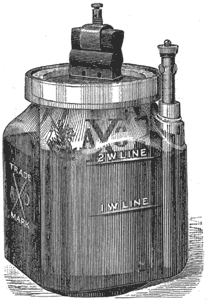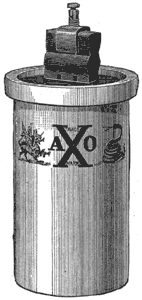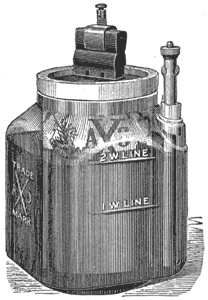[Trade Journal]
Publication: Western Electrician
Chicago, IL, United States
vol. 4, no. 6, p. 71, col. 2
The Axo Battery.
The accompanying cuts illustrate an improvement in porous cup batteries. The new battery, which is put on the market by the Leclanche Battery company, is called the Axo.
The porous cup forms of itself a cover for the cell, closing it completely, and preventing the escape of salts or liquid. The zinc passes through an independent aperture in the shoulder of the jar, which is also closed by a rubber stopple. The carbon conductor, instead of being straight, is conical or pyramidal in shape, its sides inclining outward toward the bottom and forming inclined planes, against which the particles of the surrounding mixture press, constantly, by their own weight. A contact by gravity is thus secured, which, being automatic, is maintained at all times, and under all conditions, and is never irregular and faulty, as is so often the case in the old forms. The ventilation of the cup. is. accomplished by means of deep grooves in the sides of the carbon, running along its whole length, from the bottom through and above the sealing material. This is a far more efficacious method than the old one, of piercing holes in the seal. Through these grooves the gas bubbles forming on any part of the carbon are
 |
| Fig. 1 Axo Battery, With Jar Adapted for Sealing Hermetically. |
provided with ready channels of escape, and consequently the depolarization of the element is greatly accelerated. The connection for the carbon is a metallic clamp and thumb screw, which can be removed and replaced in a moment. The peculiar shape of the jar at the bottom serves several purposes. The well in the middle keeps the bottom of the porous cup in place, and the ridge of glass surrounding it separates the cup and the zinc rod. On the outside the same well forms a depressed bottom for the cell, while the sides of the jar are raised above the level upon which it rests, and are kept free from contact with the dirt and spilled salts which collect and creep up the sides of the ordinary jars and foul the battery.
 |
| Fig. 2 Axo Battery — Porous Cup. |
The cell can be hermetically sealed without the slightest difficulty by pouring a little melted paraffine into the space between the flange of the cup and the rim of the jar, being at the same time careful not to let the wax come high enough to stop up the ventilating holes at the sides of the carbon. The advantage of sealing with paraffine is that the cup can be taken out at any time by heating the
 |
| Fig. 3 Axo Battery — Cell Unsealed. |
paraffine, or running a knife blade around between the flange of the cup and the rim of the jar. A jar is also furnished, as shown in the cut, in which the flange of the porous cup rests on the top rim of the jar instead of on a shoulder inside. This closes the jar sufficiently tight for all ordinary purposes.
